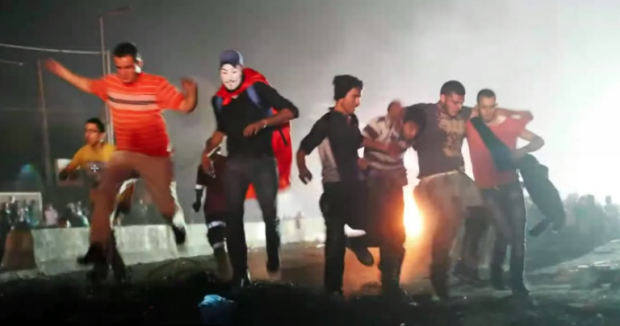On Tuesday night, curator Mohammad Salemy opened “HERE AND ELSEWHERE, AT WAR, AND INTO THE FUTURE: PALESTINE,” a hybrid online/in-person panel discussion at Whitebox Art Center. Panelists like Alex Shams and Khaled Jarrar were Skyped in while Salemy, Myriam Vanneschi, and Judith Rodenbeck sat in the gallery. Salemy began by trotting out a list of topics the discussion was not going to cover. Yes, there was a very long list of no statements, but they all pretty much boiled down to this: Don’t say “In solidarity of Palestine.” This is not without reason. The fear of these four words has a very recent history.
Last week a discussion on Palestinian art to be held at Undercurrent Projects in the East Village, “10 Days, 10 Ideas,” was cancelled by the gallery after organizers advertised the event “In solidarity of Palestine.” Undercurrent Projects justified the cancellation in an email saying neither they nor Whitebox Art Center could host “political activist meetings or sponsor political agendas.”
Rather than that particular event, Salemy said the discussion was going to address the recent show Here and Elsewhere at the New Museum, which opened on July 17 and, by happenstance, has overlapped with the most recent violent flare up in the Israeli-Palestinian conflict.
Specifically, Salemy opened the discussion with taking issue with the New Museum’s curators ignoring the politics inherent in the work on view:
“In light of current conflict, contemporary art, even if supplied from regions that have been experiencing conventional and civil war, guerrilla urban warfare, and in recent times, revolutions and coups d’état, still fails to sufficiently account for politics proper or how art can be potentially be reconfigured to anticipate and make the future. ”
So this panel discussion walked a very narrow line. It’s point was, indeed, to address the inherent politics of the New Museum show that the New Museum had ignored in their curatorial statement—where the mention of “politics” refers to a sort of politics-in-general, rather than specific events—while at the same time, panelist sidestepped any reference to being pro-Palestine. Politics without too much politics.
Salemy and many other speakers accomplished this by approaching the conversation from a theoretical standpoint, all in relation to art. He referenced Karl Marx, the readymade, and academics like Peter Osborne and Sinead Murphy. By rooting the conversation in art theory, he padded any sort of pro-Palestinian opinion; it was as if this panel intended to be a space for a removed, objective opinion, but one based in theory rather than emotion, journalism, or blatant side-taking.
However, for panelists living on the front lines of the Israel-Palestine conflict, mainly Khaled Jarrar,the conflict was less theoretical.
Jarrar is an artist now living in the West Bank. His work, which is featured both at the New Museum show and at Whitebox Art Center, shows his deep, personal involvement in the struggle, and powerlessness of those living in both Gaza and the West Bank. He himself was denied a visa by Israeli authorities to see his work in the New Museum. His most recent, untitled series of photos were shot on the front lines of a Palestinian protest, which involved a violent clash with Israeli soldiers. “Snipers were shooting without sound, so you would suddenly see the boys, girls, kids, falling, without hearing the bullet. We couldn’t see. All you could see is the falling bodies of the people.”
When Salemy interjected to ask Jarrar to step back from the conflict to address his role as an artist more theoretically, Jarrar had trouble. In the end he said, “I use art as my tool to resist occupation.”
Sitting in Whitebox, Judith Rodenbeck (art historian, critic, and past editor of Art Journal) fell on the more theoretical end of the spectrum. In one of the more introspective moments of the night, she admitted to be “speaking from a place of ethical concern rather than deep knowledge.” She spoke of the fractured nature of contemporary art as well as the precision with which rhetoric surrounding war is designed. The four words she chose to illustrate this were “We tortured some folks,” a statement President Obama made only a few days prior. For her, the word “folks” was used to mean “trivial people,” those who don’t matter.
Another panelist, Luis George Schwartz, a professor and director of the MA program in film studies at the College of Fine Arts in Ohio, fell on the more theoretical side of things as well. He spoke of Marx’s ideas of surplus populations. He also, in another introspective moment, spoke of the West’s tendency to be stuck in a pinpoint gaze: We can see beauty in a people while looking at them dying at the same time.
This divide between those sitting in Gaza and those in the Whitebox Art Center in Chinatown was palpable. The West is paying attention, but it’s a removed attention, one in which theory, numbers, and art tend to be the primary concern. For artists like Jarrar, art was definitely a concern, but its main goal is to show the horrors currently experienced by those living amid the conflict, but without much aesthetic or theoretical concern. Those sitting in the Whitebox Art Center can remove heated rhetoric about “solidarity with Palestine” from the equation by appealing to theory, but only in non-warzones is there this privilege of philosophy.
A video of the full panel discussion can be viewed here and here.



{ 1 comment }
Shame on those that claim alignment with the higher ideals of art while being unwilling to stand up for those having no way to stand up for themselves. “political” indeed. ha.
Comments on this entry are closed.